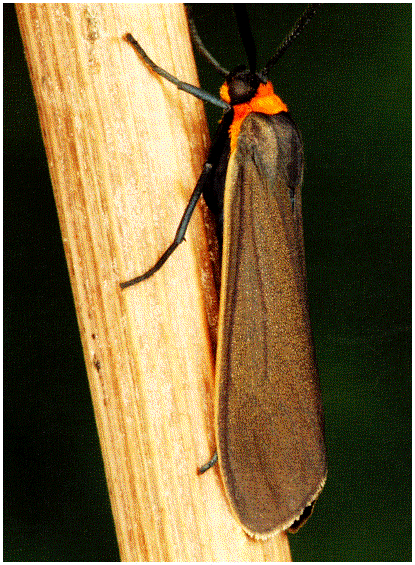Field Guide to Moths
Of Northeastern America
David Beadle
Seabrooke Leckie
(Houghton Mifflin Harcourt)

I'd leave the whole thing on the lowest flame at the back of the stove and over the week, while I was fixing various dishes, would throw in the leaves, scrapings, carrot greens, potato peels, parsley stems, odds and ends ... constantly replenishing the water, making sure it didn't cook too low.
Whenever I made rice or sauces or soups, I would take a few cups of the richly bubbling stock, and use it to add flavor and body. It always perked up a dish.
One evening, I was absently stirring the brew, I pulled up what I thought was the leaf of a turnip and I thought, I haven't eaten any turnips lately, so I pulled the 'leaf' all the way out and there it was: a big fat moth, a regular condor of the moth set, highly seasoned in the broth in which he had drowned his fool head and been simmering all week.
I said nothing to those who had shared meals with me over the previous few days. but I tell you it finally it cured me. After that, I no longer did stock pots.
What's the difference between a moth and a butterfly? For one, moths are those drab dark creepy things that fly in your face at night, immolate their little pea-brains in the candle, and clog up the mesh screen on the porch light (and drown in your stock).
Butterflies? Sun flowers color beautiful flitting by spring perfume in air singing about love through the shadows and basking on the cedar, touching down on the azalea, or button-throat, the lily-of-the-valley.
Moths, unlike butterflies, we are told, have a frenulum. It sounds vulgar ("Did you see what he did with his frenulum?") but it's just a little strut hooking the wings together. You think that sounds funny? Some moths have a lobe on the forewing called a "jugum" that helps in coupling with the hindwing. Get your hands off my jugum, she whispered.
Butterflies usually have brightly colored wings. Moths on the other hand look like your Aunt Maud: they dress in plain brown, grey, or black --- often with obscuring patterns of zigzags or swirls which help to camouflage them from predators as they rest during the day. Apparently moths aren't out there to win any beauty contests. They just want to survive.
They also have furry bodies, somewhat like a rat with wings; while butterflies have slender, smoother abdomens. Sleek they are; romantic --- although if you squash either of them ugh the same bilious juice oozes out.
Moths usually rest with their wings spread out. Butterflies will fold their wings above their backs when they are perched. Most moths are nocturnal or crepuscular while butterflies are diurnal. Diurnal is one of those lovely words that should be found in a poem, along with "cellar door." And "Ulalume:"
- And I said: "What is written, sweet sister,
On the door of this legended tomb?"
She replied: "Ulalume --- Ulalume ---
'Tis the vault of thy lost Ulalume!"
Moths have existed about 100 million years longer than butterflies, so they tend to be more laconic. Don't expect them to be spouting poetry, even as they commit suicide in your candle-flame at the dinner table or faint in the open crock-pot.
The editors have included 1,500 "of the most common or the most eye-catching," but they warn us that "more than 11,000 species of moths are currently recognized in North America." The editors also seem to be lunatics who spend an otherwise wonderful night out trapping these creeps ... using lightbulbs, lightsheets and sugar bait. They seem to think I too want to be traipsing about on a hot Florida night among the chiggers and mosquitoes to catch a couple of Leaf Blotches or Snouts or Loopers or Dicymolmia.
My take on the 500 or so pages of pictures here is enough to make me swear off moths for the rest of my days. These critturs are as ugly as sin, and some of the few worth even thinking about were nabbed by Beadle & Leckie in the frontispiece: the long Yellow collard Scrape, the Eastern Pambea (she looks like a floating pillow), and the Burdock Seedhead (quite dashing in her long gown, see Fig. 1 above).
These are the kings and queens of the whole sordid fraternity. The rest of them you can stuff. The only thing I can find lovely about most of them are their names: the Bog Bibarrambla, the Omnivorous Leafroller, the Delightful Donacaula (Delightful!), the Abrupt Brother, the Sweetfern Underwing, the Tawny Pug. Then there's the Pink-Washed Looper, the False Hemlock Looper, the Juniper-twig Geometer, and the holy of holies, The Visitation Moth.
Finally, there is the Penitent, the Betrothed, and the Pleasant Dagger. I ask you: who has time to name all these suckers, much less, name, describe and photograph them?
Just like the rest of us, every one of them has a number, called a Hodge number. I thought it was a tribute to Samuel Johnson's cat nee Hodge who liked to play with the occasional visiting moths and, after enough play, eat them. But no: turns out there was a lepidopterist named Ronald Hodges who thought so much of these flying dumb-bells that he gave them each their own personal social security number.
If for some perverse reason you still want to learn about the care and feeding of the common moth, this is your baby. It has two or three thousand individual moth shots (in color), along with habitant, common name, scientific name, favorite plants, size and color.